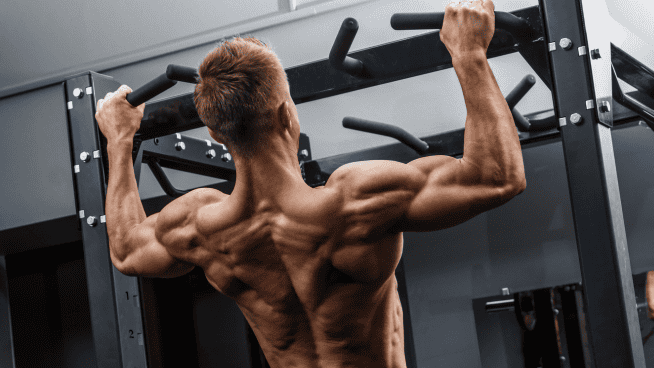How to Finally Barbell Overhead Press Without Pain
Some lifters experience shoulder pain or discomfort when performing common vertical barbell pressing movements such as Military and Push Presses. A lack of shoulder/thoracic spine mobility and/or previous shoulder injuries are the likely culprits for these issues.
A common recommendation for individuals who can’t overhead press with a straight bar is to switch to Dumbbell and Landmine Presses, both of which favor pain-free pressing.
While that’s certainly good advice, omitting the barbell in overhead pressing movements removes an important tool for building bigger and stronger shoulders from your toolbox.
It’s like hiring a handyman to install a new set of windows in your kitchen, but banning the use of a saw to cut and shape the window frames. He’ll probably get the job done in the end, but likely not in the most effective manner.
Fortunately, you don’t have to try to cut window frames with a hammer, nor do you have to toss all vertical Barbell Presses out of your program. There are a handful of Barbell Overhead Press variations that many people who cannot otherwise perform moves like Military Presses can nail with zero pain. Give these three a shot and hammer your delts without beating up your joints.
1. Seated Barbell Press off Pins
The Seated Barbell Press off Pins is a fantastic exercise that suits a wide berth of rep ranges.
Play around with pin height to determine your optimal starting position. Begin with the bar below your chin and press it up. No issues moving the weight through a full range of motion? Then stick with it. However, if your shoulders feel iffy, bring the pins up to chin or mouth height for a safer pressing angle.
In addition to smashing your anterior deltoids with sets of eight to ten reps, you could also perform low-rep, maximal strength work with singles and doubles. But given that shoulder issues may prevent you from standard military pressing in the first place, it’s probably best to stay on the safe side here, as well. So, keep your reps at three and above per set to play it safe.
If you’re more concerned with improving concentric pressing strength, use a fast eccentric, as seen in the video above. It’s still a controlled lowering phase, albeit a very fast one. The pins will catch the bar at the bottom, so there’s no harm in letting gravity bring it down quickly. To prolong time under tension, emphasize the eccentric part by taking 3 to 5 seconds to lower the bar. You’ll have to go lighter, but the amazing burn in your shoulders will more than make up for it.
Recommended Sets and Reps: 3-5 x 3-10
2. Z Press
Named after famed Lithuanian strongman Zydrunas Savickas, the Z Press is a Seated Overhead Press from the floor.
Some people keep their legs straight and pressed together, but I like to spread them out with slightly bent knees for a more stable base to press off. Try different foot positions to find out what feels most natural for you.
Stopping just shy of lockout at the top is also a good idea for anyone who’s suffered from shoulder issues. This neat little trick helps take tension off your shoulder joint and keeps it on the pressing muscles.
If you perform Z Presses alone, unracking and racking the bar could pose some difficulty. As you see in the video, I unrack the bar, then awkwardly inch my way forward, because otherwise, I would hit the J-hooks on every rep. This is obviously not optimal.
You can try facing the rack, in which case you only need to lean slightly back to clear the J-hooks (but leaning too far will shift your balance and you’ll end up lying on your back with the weight pinning you to the floor). By far your best bet is to have a spotter (or two) hand the bar to you at the beginning and help you re-rack it after your set.
Recommended Sets and Reps: 3-5 x 6-12
3. Viking Press
I really like the Double Landmine Press as a bilateral vertical pressing movement (technically, it’s not a true vertical press, since the bar moves diagonally away from your body; but you get the point). Done in moderate rep ranges (say, 8-12 reps per set), you’ll experience some awesome front delt pumps.
The problem with the Double Landmine Press is that you will rarely find two landmine stations next to each other in a public gym. So, it’s not a super practical choice in most occasions and environments.
The Viking Press solves this issue by eliminating the landmine setup altogether. You just need a sturdy power rack with safety pins and two barbells. Most gyms stock those. And if yours doesn’t have them, that’s a good enough reason to switch to a gym that does.
Often used in strongman competitions, the Viking Press is a fantastic shoulder builder. I picked up the variation seen in the video above from Paul Carter over at T Nation.
The trick here is to set up the pins at different heights in a power rack. The pressing end should be one or two holes below the other end. You’ll also want to add a small 5-pound plate to the non-moving end to keep the bar in place throughout your set.
Recommended Sets and Reps: 3-5 x 8-12
Photo Credit: mihailomilovanovic/iStock
READ MORE FROM YUNUS BARISIK:
RECOMMENDED FOR YOU
MOST POPULAR
How to Finally Barbell Overhead Press Without Pain
Some lifters experience shoulder pain or discomfort when performing common vertical barbell pressing movements such as Military and Push Presses. A lack of shoulder/thoracic spine mobility and/or previous shoulder injuries are the likely culprits for these issues.
A common recommendation for individuals who can’t overhead press with a straight bar is to switch to Dumbbell and Landmine Presses, both of which favor pain-free pressing.
While that’s certainly good advice, omitting the barbell in overhead pressing movements removes an important tool for building bigger and stronger shoulders from your toolbox.
It’s like hiring a handyman to install a new set of windows in your kitchen, but banning the use of a saw to cut and shape the window frames. He’ll probably get the job done in the end, but likely not in the most effective manner.
Fortunately, you don’t have to try to cut window frames with a hammer, nor do you have to toss all vertical Barbell Presses out of your program. There are a handful of Barbell Overhead Press variations that many people who cannot otherwise perform moves like Military Presses can nail with zero pain. Give these three a shot and hammer your delts without beating up your joints.
1. Seated Barbell Press off Pins
The Seated Barbell Press off Pins is a fantastic exercise that suits a wide berth of rep ranges.
Play around with pin height to determine your optimal starting position. Begin with the bar below your chin and press it up. No issues moving the weight through a full range of motion? Then stick with it. However, if your shoulders feel iffy, bring the pins up to chin or mouth height for a safer pressing angle.
In addition to smashing your anterior deltoids with sets of eight to ten reps, you could also perform low-rep, maximal strength work with singles and doubles. But given that shoulder issues may prevent you from standard military pressing in the first place, it’s probably best to stay on the safe side here, as well. So, keep your reps at three and above per set to play it safe.
If you’re more concerned with improving concentric pressing strength, use a fast eccentric, as seen in the video above. It’s still a controlled lowering phase, albeit a very fast one. The pins will catch the bar at the bottom, so there’s no harm in letting gravity bring it down quickly. To prolong time under tension, emphasize the eccentric part by taking 3 to 5 seconds to lower the bar. You’ll have to go lighter, but the amazing burn in your shoulders will more than make up for it.
Recommended Sets and Reps: 3-5 x 3-10
2. Z Press
Named after famed Lithuanian strongman Zydrunas Savickas, the Z Press is a Seated Overhead Press from the floor.
Some people keep their legs straight and pressed together, but I like to spread them out with slightly bent knees for a more stable base to press off. Try different foot positions to find out what feels most natural for you.
Stopping just shy of lockout at the top is also a good idea for anyone who’s suffered from shoulder issues. This neat little trick helps take tension off your shoulder joint and keeps it on the pressing muscles.
If you perform Z Presses alone, unracking and racking the bar could pose some difficulty. As you see in the video, I unrack the bar, then awkwardly inch my way forward, because otherwise, I would hit the J-hooks on every rep. This is obviously not optimal.
You can try facing the rack, in which case you only need to lean slightly back to clear the J-hooks (but leaning too far will shift your balance and you’ll end up lying on your back with the weight pinning you to the floor). By far your best bet is to have a spotter (or two) hand the bar to you at the beginning and help you re-rack it after your set.
Recommended Sets and Reps: 3-5 x 6-12
3. Viking Press
I really like the Double Landmine Press as a bilateral vertical pressing movement (technically, it’s not a true vertical press, since the bar moves diagonally away from your body; but you get the point). Done in moderate rep ranges (say, 8-12 reps per set), you’ll experience some awesome front delt pumps.
The problem with the Double Landmine Press is that you will rarely find two landmine stations next to each other in a public gym. So, it’s not a super practical choice in most occasions and environments.
The Viking Press solves this issue by eliminating the landmine setup altogether. You just need a sturdy power rack with safety pins and two barbells. Most gyms stock those. And if yours doesn’t have them, that’s a good enough reason to switch to a gym that does.
Often used in strongman competitions, the Viking Press is a fantastic shoulder builder. I picked up the variation seen in the video above from Paul Carter over at T Nation.
The trick here is to set up the pins at different heights in a power rack. The pressing end should be one or two holes below the other end. You’ll also want to add a small 5-pound plate to the non-moving end to keep the bar in place throughout your set.
Recommended Sets and Reps: 3-5 x 8-12
Photo Credit: mihailomilovanovic/iStock
READ MORE FROM YUNUS BARISIK:












